Voyager’s Jupiter And Io

Voyager’s Jupiter and Io
More Posts from Jovian-witch and Others

Burn for wealth and employment.
From Scott Cunningham’s The Complete Book of Incense, Oils, and Brews
Solar System 10 Things: Two Years of Juno at Jupiter
Our Juno mission arrived at the King of Planets in July 2016. The intrepid robotic explorer has been revealing Jupiter’s secrets ever since.
Here are 10 historic Juno mission highlights:

1. Arrival at a Colossus
After an odyssey of almost five years and 1.7 billion miles (2.7 billion kilometers), our Juno spacecraft fired its main engine to enter orbit around Jupiter on July 4, 2016. Juno, with its suite of nine science instruments, was the first spacecraft to orbit the giant planet since the Galileo mission in the 1990s. It would be the first mission to make repeated excursions close to the cloud tops, deep inside the planet’s powerful radiation belts.

2. Science, Meet Art
Juno carries a color camera called JunoCam. In a remarkable first for a deep space mission, the Juno team reached out to the general public not only to help plan which pictures JunoCam would take, but also to process and enhance the resulting visual data. The results include some of the most beautiful images in the history of space exploration.

3. A Whole New Jupiter
It didn’t take long for Juno—and the science teams who hungrily consumed the data it sent home—to turn theories about how Jupiter works inside out. Among the early findings: Jupiter’s poles are covered in Earth-sized swirling storms that are densely clustered and rubbing together. Jupiter’s iconic belts and zones were surprising, with the belt near the equator penetrating far beneath the clouds, and the belts and zones at other latitudes seeming to evolve to other structures below the surface.
4. The Ultimate Classroom
The Goldstone Apple Valley Radio Telescope (GAVRT) project, a collaboration among NASA, JPL and the Lewis Center for Educational Research, lets students do real science with a large radio telescope. GAVRT data includes Jupiter observations relevant to Juno, and Juno scientists collaborate with the students and their teachers.
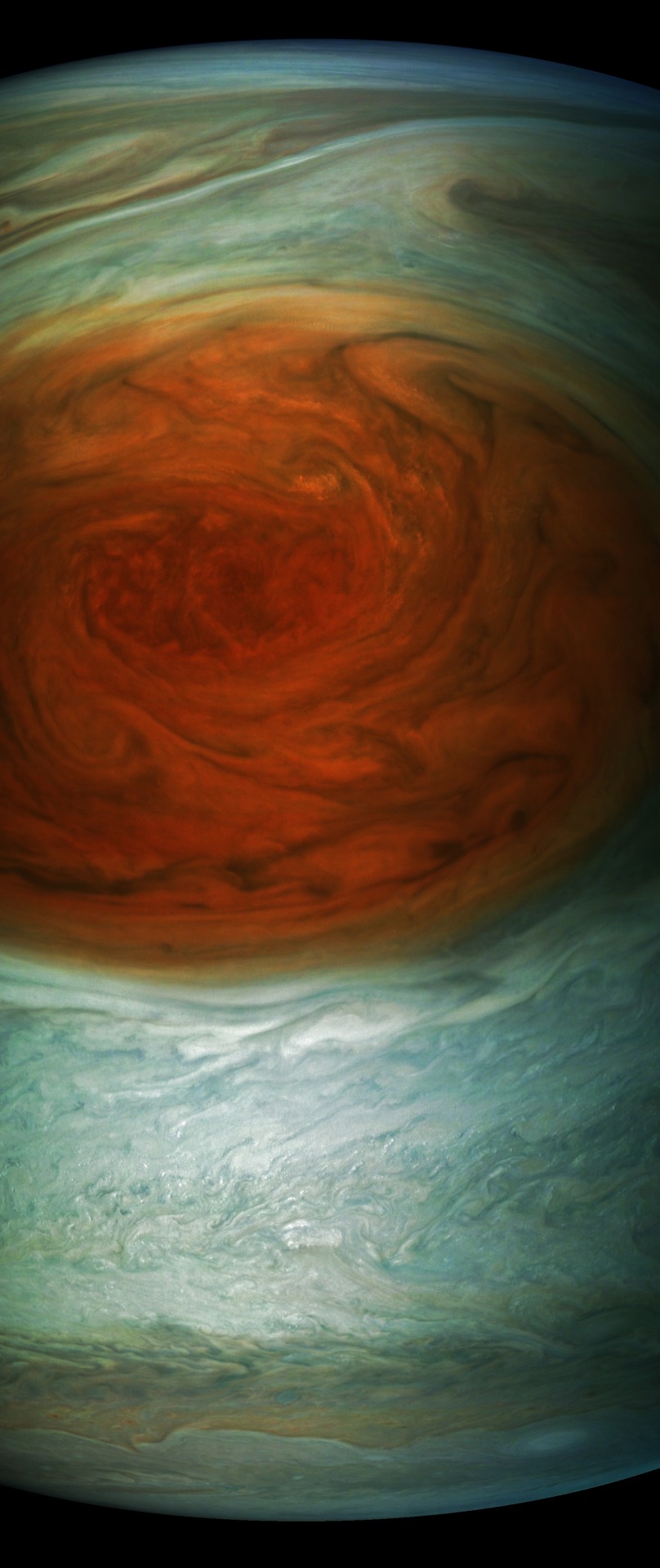
5. Spotting the Spot
Measuring in at 10,159 miles (16,350 kilometers) in width (as of April 3, 2017) Jupiter’s Great Red Spot is 1.3 times as wide as Earth. The storm has been monitored since 1830 and has possibly existed for more than 350 years. In modern times, the Great Red Spot has appeared to be shrinking. In July 2017, Juno passed directly over the spot, and JunoCam images revealed a tangle of dark, veinous clouds weaving their way through a massive crimson oval.
“For hundreds of years scientists have been observing, wondering and theorizing about Jupiter’s Great Red Spot,” said Scott Bolton, Juno principal investigator from the Southwest Research Institute in San Antonio. “Now we have the best pictures ever of this iconic storm. It will take us some time to analyze all the data from not only JunoCam, but Juno’s eight science instruments, to shed some new light on the past, present and future of the Great Red Spot.”

6. Beauty Runs Deep
Data collected by the Juno spacecraft during its first pass over Jupiter’s Great Red Spot in July 2017 indicate that this iconic feature penetrates well below the clouds. The solar system’s most famous storm appears to have roots that penetrate about 200 miles (300 kilometers) into the planet’s atmosphere.

7. Powerful Auroras, Powerful Mysteries
Scientists on the Juno mission observed massive amounts of energy swirling over Jupiter’s polar regions that contribute to the giant planet’s powerful auroras – only not in ways the researchers expected. Examining data collected by the ultraviolet spectrograph and energetic-particle detector instruments aboard Juno, scientists observed signatures of powerful electric potentials, aligned with Jupiter’s magnetic field, that accelerate electrons toward the Jovian atmosphere at energies up to 400,000 electron volts. This is 10 to 30 times higher than the largest such auroral potentials observed at Earth.
Jupiter has the most powerful auroras in the solar system, so the team was not surprised that electric potentials play a role in their generation. What puzzled the researchers is that despite the magnitudes of these potentials at Jupiter, they are observed only sometimes and are not the source of the most intense auroras, as they are at Earth.
8. Heat from Within
Juno scientists shared a 3D infrared movie depicting densely packed cyclones and anticyclones that permeate the planet’s polar regions, and the first detailed view of a dynamo, or engine, powering the magnetic field for any planet beyond Earth (video above). Juno mission scientists took data collected by the spacecraft’s Jovian InfraRed Auroral Mapper (JIRAM) instrument and generated a 3D fly-around of the Jovian world’s north pole.
Imaging in the infrared part of the spectrum, JIRAM captures light emerging from deep inside Jupiter equally well, night or day. The instrument probes the weather layer down to 30 to 45 miles (50 to 70 kilometers) below Jupiter’s cloud tops.

9. A Highly Charged Atmosphere
Powerful bolts of lightning light up Jupiter’s clouds. In some ways its lightning is just like what we’re used to on Earth. In other ways,it’s very different. For example, most of Earth’s lightning strikes near the equator; on Jupiter, it’s mostly around the poles.

10. Extra Innings
In June, we approved an update to Juno’s science operations until July 2021. This provides for an additional 41 months in orbit around. Juno is in 53-day orbits rather than 14-day orbits as initially planned because of a concern about valves on the spacecraft’s fuel system. This longer orbit means that it will take more time to collect the needed science data, but an independent panel of experts confirmed that Juno is on track to achieve its science objectives and is already returning spectacular results. The spacecraft and all its instruments are healthy and operating nominally.
Read the full web version of this week’s ‘Solar System: 10 Things to Know’ article HERE.
For regular updates, follow NASA Solar System on Twitter and Facebook.
Make sure to follow us on Tumblr for your regular dose of space: http://nasa.tumblr.com
![My Images Of Mars, Jupiter, And Saturn Taken With A Cheap Webcam And Telescope. [OC] Via /r/spaceporn](https://64.media.tumblr.com/8b04e71b2cad388b036afb649af8b7ba/2e4659443b845038-fb/s500x750/ed27aaea68956836311dbf6cc91bc65bb0013e0a.jpg)
My images of Mars, Jupiter, and Saturn taken with a cheap webcam and telescope. [OC] via /r/spaceporn https://ift.tt/3jXNrDk


Planetary Witches / Jupiter Aesthetic
Visit my shop





CGI renderings of Jupiter, ‘King of the Planets’
The largest planet in the Solar System, likely the first planet to form after the Sun did, continues to dominate over the System with its almost 80 moons and immensely steep and influential gravity well.
Keep reading
“Jupiter, you were larger than life, unfathomable to my small-town sensibilities. My heart couldn’t comprehend all of you at once. But this wasn’t my first rodeo; life had hurled love at me before. Step one of my plan: play hard to get. But, fuck, you called me and I came flying like an asteroid. So I chucked plans and lists out the window for you, threw my heart into your hands. Good thing you’re a good catch as well as a catch. Spontaneous lover, you danced and made up the steps as you went along. We kissed like giggling teenagers, we gossiped like cackling old women. You taught me rap songs, you took me to playgrounds at midnight so I could look at the star streaked sky while you pushed the swing higher and higher, until I was floating, until I felt as infinite as you. You kissed me until I tasted lightning.”
— the nine people i have loved as planets: jupiter // L.H.
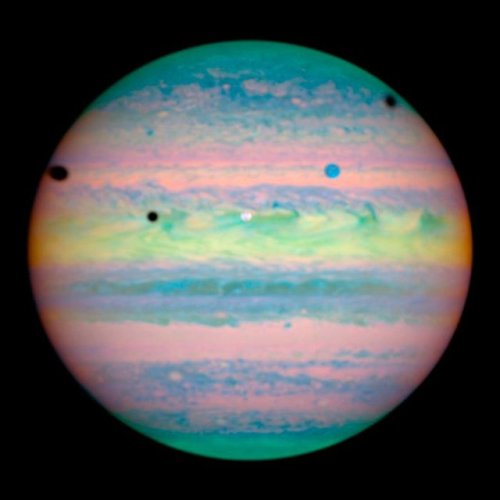
In this composite image from near-infrared light, two of Jupiter’s moons are visible against the planet. The white circle in the middle of Jupiter is Io, and the blue circle at upper right is Ganymede. The three black spots are shadows cast by Io, Ganymede, and another moon, Callisto.
Image Credit: NASA, ESA, and E. Karkoschka (University of Arizona)
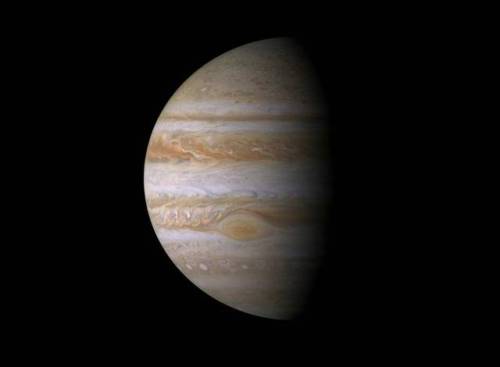
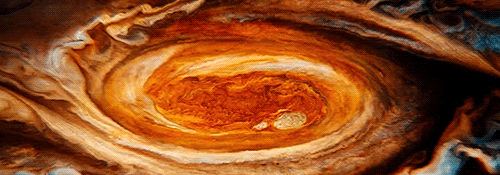
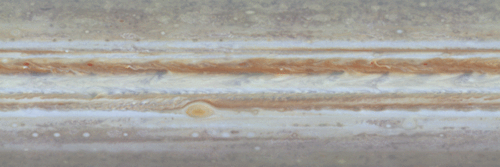
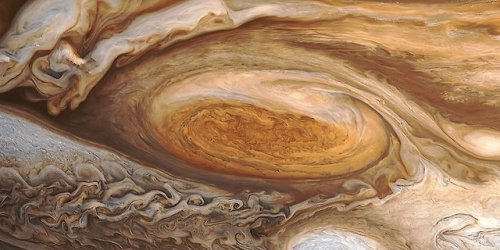
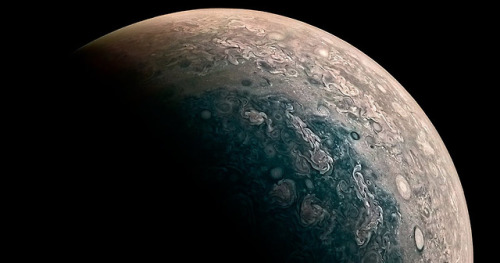
Jupiter is perpetually covered with clouds composed of ammonia crystals and possibly ammonium hydrosulfide. The clouds are located in the tropopause and are arranged into bands of different latitudes, known as tropical regions. These are sub-divided into lighter-hued zones and darker belts. The interactions of these conflicting circulation patterns cause storms and turbulence. Wind speeds of 100 m/s (360 km/h) are common in zonal jets. The zones have been observed to vary in width, color and intensity from year to year, but they have remained sufficiently stable for scientists to give them identifying designations.
The cloud layer is only about 50 km (31 mi) deep, and consists of at least two decks of clouds: a thick lower deck and a thin clearer region. There may also be a thin layer of water clouds underlying the ammonia layer. Supporting the idea of water clouds are the flashes of lightning detected in the atmosphere of Jupiter. These electrical discharges can be up to a thousand times as powerful as lightning on Earth. The water clouds are assumed to generate thunderstorms in the same way as terrestrial thunderstorms, driven by the heat rising from the interior.
source

Spell Circle
Purpose: To sanctify and maintain a space
Recommended Casting Type: Altar
Recommended Anchor: Wood
Outer Ring Translation: “Sanctify this space. Only my circle of spirits and gods may enter.”
Language: English
Script: Woevian
Planetary Correspondences: Sun/Jupiter/Saturn
Directional Correspondences: Center
Color Correspondences: Silver
Numerology: 0/1/3

Mix with 1/8 c. base oil and wear for wealth, prosperity, and to help in legal matters.
From Scott Cunningham’s The Complete Book of Incense, Oils, and Brews
-
 carlottaragazzaloveeur reblogged this · 3 weeks ago
carlottaragazzaloveeur reblogged this · 3 weeks ago -
 carlottaragazzaloveeur liked this · 3 weeks ago
carlottaragazzaloveeur liked this · 3 weeks ago -
 oclcl liked this · 7 months ago
oclcl liked this · 7 months ago -
 junkmanserenade reblogged this · 7 months ago
junkmanserenade reblogged this · 7 months ago -
 shaman-chant reblogged this · 7 months ago
shaman-chant reblogged this · 7 months ago -
 shaman-chant liked this · 7 months ago
shaman-chant liked this · 7 months ago -
 booklover51 liked this · 1 year ago
booklover51 liked this · 1 year ago -
 l-ozio liked this · 1 year ago
l-ozio liked this · 1 year ago -
 c0smicdrift3r reblogged this · 1 year ago
c0smicdrift3r reblogged this · 1 year ago -
 starlighthymns reblogged this · 1 year ago
starlighthymns reblogged this · 1 year ago -
 starlighthymns liked this · 1 year ago
starlighthymns liked this · 1 year ago -
 ummakflower liked this · 1 year ago
ummakflower liked this · 1 year ago -
 pictonatural liked this · 1 year ago
pictonatural liked this · 1 year ago -
 youcefsakhi reblogged this · 1 year ago
youcefsakhi reblogged this · 1 year ago -
 youcefsakhi liked this · 1 year ago
youcefsakhi liked this · 1 year ago -
 c0smicdrift3r reblogged this · 1 year ago
c0smicdrift3r reblogged this · 1 year ago -
 c0smicdrift3r liked this · 1 year ago
c0smicdrift3r liked this · 1 year ago -
 voidwoken reblogged this · 1 year ago
voidwoken reblogged this · 1 year ago -
 voidwoken liked this · 1 year ago
voidwoken liked this · 1 year ago -
 toitaliclygo reblogged this · 1 year ago
toitaliclygo reblogged this · 1 year ago -
 toitaliclygo liked this · 1 year ago
toitaliclygo liked this · 1 year ago -
 master-of-all reblogged this · 1 year ago
master-of-all reblogged this · 1 year ago -
 a-shower-of-roses reblogged this · 1 year ago
a-shower-of-roses reblogged this · 1 year ago -
 princelycosmos reblogged this · 1 year ago
princelycosmos reblogged this · 1 year ago -
 dragonerowu liked this · 1 year ago
dragonerowu liked this · 1 year ago -
 thedevilssacrement reblogged this · 1 year ago
thedevilssacrement reblogged this · 1 year ago -
 thedevilssacrement liked this · 1 year ago
thedevilssacrement liked this · 1 year ago -
 ouranien reblogged this · 1 year ago
ouranien reblogged this · 1 year ago -
 apaimorne liked this · 1 year ago
apaimorne liked this · 1 year ago -
 tiidings reblogged this · 1 year ago
tiidings reblogged this · 1 year ago -
 godofred42069 reblogged this · 1 year ago
godofred42069 reblogged this · 1 year ago -
 jamierthanyou reblogged this · 1 year ago
jamierthanyou reblogged this · 1 year ago -
 arowithwood reblogged this · 1 year ago
arowithwood reblogged this · 1 year ago -
 ocean--grey reblogged this · 1 year ago
ocean--grey reblogged this · 1 year ago -
 wednesdaydreams liked this · 2 years ago
wednesdaydreams liked this · 2 years ago -
 haderhater liked this · 2 years ago
haderhater liked this · 2 years ago -
 thequietabsolute reblogged this · 2 years ago
thequietabsolute reblogged this · 2 years ago -
 leproserie liked this · 2 years ago
leproserie liked this · 2 years ago -
 lesblizzard-ultradyke liked this · 2 years ago
lesblizzard-ultradyke liked this · 2 years ago

blog dedicated to my work with the planet Jupiter
96 posts